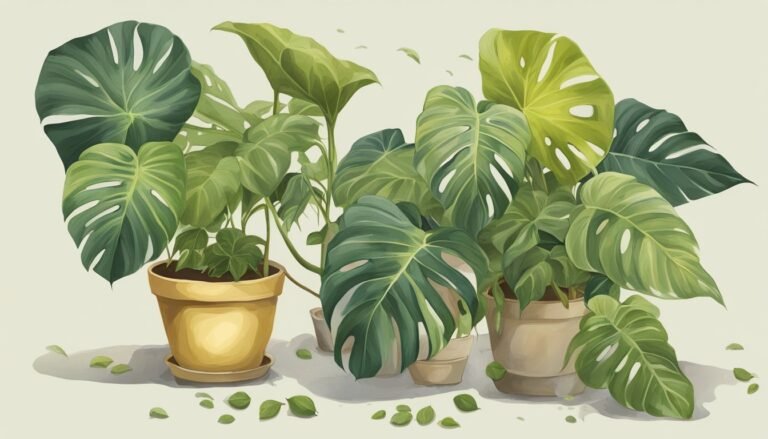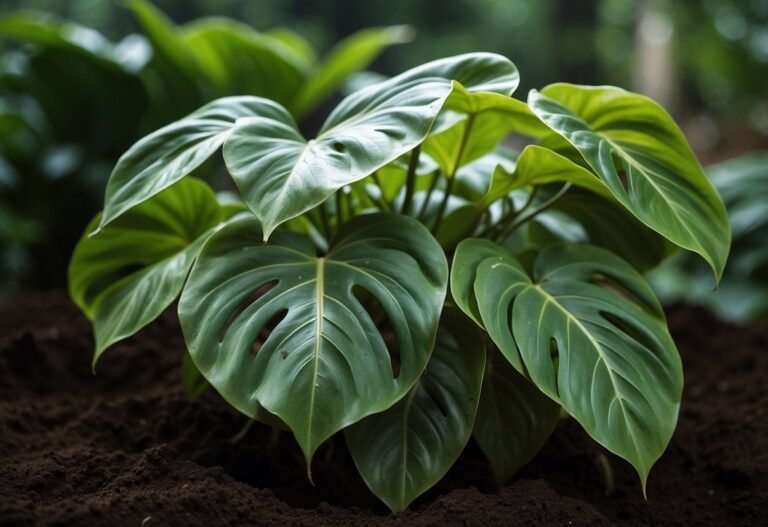Longilobatum Information on Philodendron: Key Facts and Care Guidelines
When I started collecting tropical plants, I wanted something unique that would stand out in my space. The Philodendron longilobatum quickly caught my eye with its long, pointed leaves and striking serrated edges, making it a rare and fascinating addition to any collection.
Originating from Brazil, this climbing plant is known not just for its unusual appearance, but also for being relatively easy to care for compared to other exotic specimens.

As I learned more, I was surprised by how large and impressive the leaves of the Philodendron longilobatum can get—sometimes reaching up to four feet in length. Its air-purifying qualities, bold look, and adaptable care needs make it an attractive choice for plant lovers searching for something special.
Whether you are a beginner or an experienced grower, this plant is sure to become a highlight in your collection.
Longilobatum Overview

Philodendron longilobatum is prized for its unique leaf shape, unusual growth habits, and its origins in South America. I focus on the exact features and background details that set this plant apart in the Philodendron genus.
Defining Longilobatum in Philodendron
When I discuss longilobatum in Philodendron, I am referring to a specific type of climbing tropical plant recognized for its dramatic, elongated leaves. The name “longilobatum” describes the long, deep lobes found along the leaf edges, making it instantly recognizable among other Philodendron species.
This plant is often grown for ornamental purposes, especially by collectors who appreciate rare and eye-catching foliage. The long, serrated or jagged edges of the leaves give it a bold appearance.
Philodendron longilobatum can adapt to both indoor and outdoor environments when given sufficient moisture and appropriate light. This makes it a versatile choice for plant enthusiasts looking for something different.
Distinguishing Features
One of the most noticeable traits of Philodendron longilobatum is its large, narrow leaves. The leaves can reach up to 4 feet long in mature plants and are deep, glossy green with sharply pointed tips.
Jagged or serrated leaf margins add to the plant’s dramatic look. I often see this called a “great dragonfly” shape, referring to the narrow, extended lobes and overall structure of its leaves.
A summary of key features:
- Leaf length: Up to 4 feet
- Color: Dark green
- Shape: Elongated, deeply lobed, and pointed
- Edge: Serrated or jagged
Learn more about the distinctive foliage of longilobatum.
Origins and Botanical Classification
Philodendron longilobatum is native to Brazil, where it grows in tropical forests. I find that it climbs along trees, using aerial roots to anchor itself as it seeks light above the canopy.
Belonging to the Araceae family, it shares characteristics with other aroids but stands out due to its unusual leaf structure.
Within the genus Philodendron, longilobatum is categorized as a climber. One well-known variety is the ‘Leylano Miyano,’ which is named after a naturalist and has become a collector’s item due to its impressive size and leaf form.
Botanists recognize it for both its beauty and its adaptability in various environments. Find more information about its origin and classification.
Key Characteristics of Philodendron Longilobatum

I find that Philodendron longilobatum stands out due to its distinct leaf shape, growth habit, and appealing coloration. The plant adapts well both indoors and outdoors when provided the right light and moisture.
Leaf Structure and Growth Pattern
The leaves of Philodendron longilobatum are narrow, long, and have pointed tips. Each leaf features deep lobes and jagged edges, giving it a unique, dragonfly-like look.
Mature leaves can appear even more pronounced, with the lobes becoming deeper and the edges more irregular. I observe that this species grows as an epiphyte in its native habitat, stretching its elongated petioles to reach available light.
The petioles are unusually long, which allows the plant to grow outward and receive better light exposure. In areas with high humidity, it will develop many aerial roots, which add to its visual interest and help support the plant as it climbs.
When grown indoors, keeping the soil moist and providing bright, indirect light encourages healthy leaf development and prevents sluggish growth. A regular routine of misting helps mimic the high humidity it prefers in the wild.
Unique Coloration and Texture
One key visual feature is the dark green coloration of its leaves. Certain cultivated varieties, such as the ‘Lelano Miyano’ variegated form, display patches of lighter green or creamy white, making them highly attractive and popular among collectors.
I notice the leaves have a very smooth, slightly glossy surface that enhances their ornamental value. In high humidity, the leaves remain supple and lush, while low humidity may result in a duller appearance.
The striking color contrasts are even more noticeable under bright, indirect light, which helps the plant retain its vivid shades. The combination of the unique leaf shape and rich coloring gives Philodendron longilobatum lasting appeal.
This species is especially valued for its ability to add an exotic look to any tropical plant collection. For more details about its natural habitat and care, I recommend checking this reference and a cultivar with variegated leaves.
Cultivation and Care Recommendations
I focus on a few important factors when caring for Philodendron longilobatum. Paying attention to light, water, soil, and common plant issues helps me keep my plant healthy and thriving.
Optimal Light and Watering Conditions
For best growth, I keep my Philodendron longilobatum in bright, indirect sunlight. Direct sun can scorch the leaves, so I avoid placing it near windows with strong afternoon rays.
The plant can handle low light, but it will grow slower and may lose some of its vibrant color. I water only when the top inch of soil feels dry.
Too much water causes root rot, which is a common problem for this species. Usually, my plant needs about 0.8 cups of water every 9 days if it’s in a 5-inch pot and not in direct sunlight.
I check soil moisture with my finger before watering. In the warmer months, I may water more often, while in winter, I cut back to prevent soggy soil.
Read more about these needs on this detailed plant care guide.
Soil Requirements
I always use well-draining soil for my Philodendron longilobatum. This helps prevent water from pooling around the roots, which can quickly lead to rot.
A mix of coco coir or peat moss, perlite, and some organic compost works well. I avoid using heavy soils or regular garden dirt, as these hold too much water.
The ideal mixture should feel light and airy. I sometimes add a bit of vermiculite for extra drainage.
The soil should also be rich in organic matter to encourage healthy leaves and growth. Suggestions for well-draining blends are available in this care guide.
Common Challenges and Solutions
Root rot is a frequent issue if I overwater or use dense soil. I make sure my pot has drainage holes.
If leaves turn yellow or mushy, I cut away damaged roots and repot in fresh, dry soil. Sometimes, my plant’s growth slows or leaves look pale.
This usually means it needs more light or a balanced liquid fertilizer during spring and summer. Philodendron longilobatum can also attract pests like spider mites.
I clean the leaves and check for webs or spots, wiping them with a damp cloth and using insecticidal soap when needed. When humidity drops, especially in winter, I mist the plant or use a humidifier to avoid brown leaf edges.
For more troubleshooting tips, I follow guides like this basic care guide.
Propagation and Acquisition
I have found that Philodendron longilobatum can be propagated at home, but care is needed to ensure healthy growth. When looking to obtain a plant, it is important to know how to tell genuine specimens from other philodendrons, as well as where to buy from trusted sources.
Effective Propagation Techniques
To propagate Philodendron longilobatum, I use stem cuttings or air layering. For stem cuttings, I always make sure each cutting includes at least one node and an attached leaf.
Here is my process for stem cuttings:
- Use sterilized scissors.
- Cut below a node, making sure the node is healthy.
- Let the cut end dry for several hours to reduce the risk of rotting.
- Place the cutting in water or moist sphagnum moss.
- Keep the environment humid and warm for fast rooting.
Air layering is another method I have tried. This involves wounding the stem and wrapping it in moist moss until roots develop, which is slower but can be less stressful for mature plants.
Both methods have given me good results when I pay close attention to cleanliness and humidity. More details can be found in this Philodendron care guide.
Sourcing Authentic Longilobatum Specimens
When acquiring Philodendron longilobatum, I recommend reputable sellers that offer verified plants. This reduces the risk of getting mislabeled or unhealthy specimens.
Key points to consider:
- Ask for actual photos of the plant.
- Look for vendors that show the root system.
- Prefer sellers that list clear pot sizes and plant age.
Sometimes I see tissue-cultured offerings for consistency, but I double-check that they are genuine. A good example of a vendor showing exact plants for sale is this specialty shop.
It is best to avoid buying from unknown sources, as hybrids or misidentified plants are common. I seek sellers who communicate quickly and can answer specific questions about the plant’s origin and care needs.
Frequently Asked Questions
I answer common concerns about Philodendron Longilobatum care, differences with similar plants, and potential issues with watering and propagation. I also touch on growth expectations and how to recognize and keep variegation.
How do I care for a Philodendron Longilobatum plant?
I keep my Philodendron Longilobatum in bright, indirect light. Direct sunlight can scorch the leaves.
I let the top inch of soil dry before watering. Too much water can cause root rot.
This plant prefers high humidity but will grow in average indoor air. I use well-draining, chunky potting mix for the best root health.
What are the differences between Philodendron Longilobatum and Philodendron Lelano Miyano?
Philodendron Lelano Miyano is often confused with Longilobatum. I’ve noticed that Longilobatum has deeply lobed, slender leaves, while Lelano Miyano’s leaves can look broader.
Leaf shape and lobes are the easiest way for me to tell them apart. Checking for leaf stickiness may help, as the Lelano Miyano sometimes has different surface textures, according to some plant collectors.
Can Philodendron Longilobatum develop variegation, and if so, how is it maintained?
Philodendron Longilobatum rarely develops natural variegation. If I do see variegation, it is usually unstable and can fade.
To keep any variegation, I provide plenty of indirect sunlight. I try to avoid over-fertilizing, since strong fertilizers may stress the plant and cause variegation to disappear.
What is the expected growth rate and mature size of Philodendron Longilobatum?
This plant grows faster in warm, humid conditions with consistent care. In my experience, it can put out new leaves every few weeks during the growing season.
A mature Philodendron Longilobatum can reach several feet in height if given a moss pole or other support.
How should a Philodendron Longilobatum be propagated?
I propagate this plant using stem cuttings with at least one node. After letting the cut end callous for a day, I place it in water or moist sphagnum moss.
New roots form in a few weeks. Once roots are at least two inches long, I move the cutting into soil.
What are the signs of overwatering in a Philodendron Longilobatum?
Wilting or yellowing leaves are often the first signs I look for. Mushy stems or a musty smell from the potting mix also indicate overwatering.
Root rot can develop if water sits in the pot for too long. Making sure my pot has drainage holes and not watering too often helps prevent these problems.




